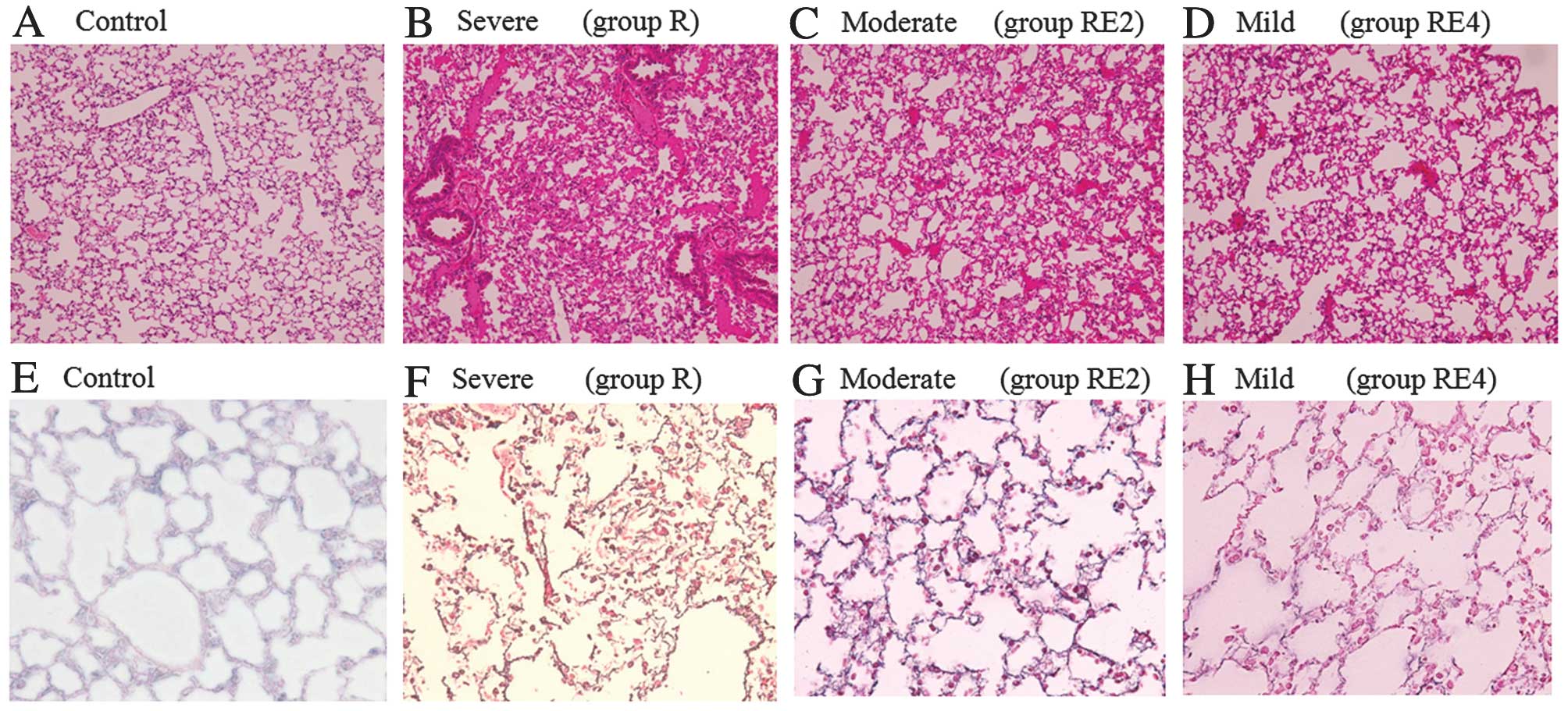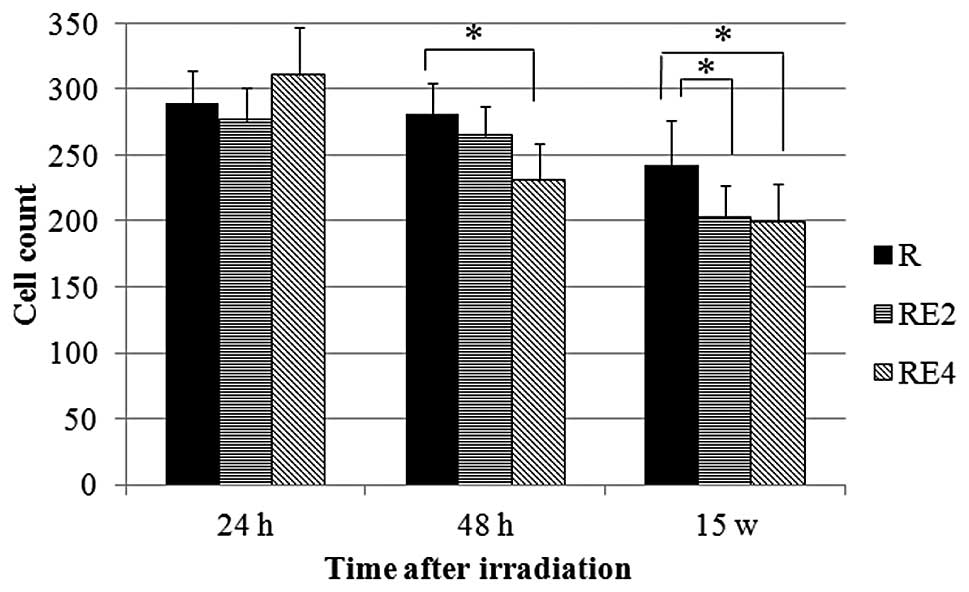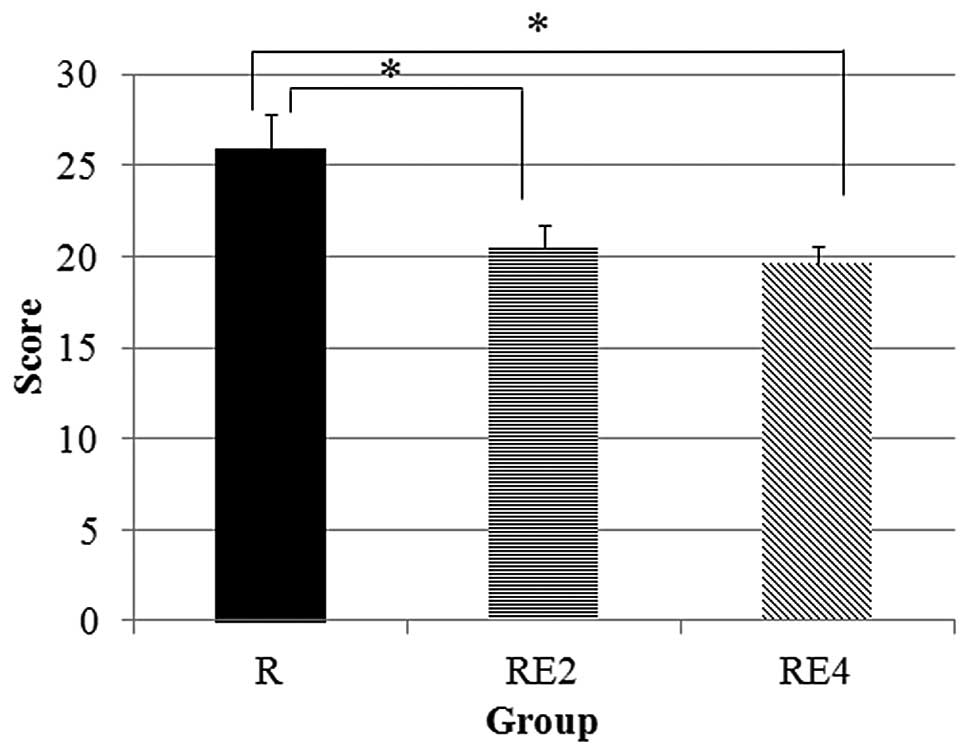Sivelestat sodium hydrate reduces radiation-induced lung injury in mice by inhibiting neutrophil elastase
- Authors:
- Published online on: February 8, 2013 https://doi.org/10.3892/mmr.2013.1318
- Pages: 1091-1095
Abstract
Introduction
The lung is a radiosensitive organ, and the radiotherapy of cancer in the thoracic region is able to cause radiation-induced lung injury (RILI), sometimes resulting in mortality (1). Protection of the lungs against irradiation renders radiation therapy safer for patients with risk factors for RILI and may enable the delivery of more or greater radiation doses to tumors, to improve clinical outcomes.
Neutrophil elastase (NE), a serine protease present in the azurophil granules of neutrophils, is released in an inflammatory state and disintegrates extracellular matrices due to its low substrate specificity, resulting in tissue injury (2,3). Sivelestat [sodium N-[2-[4-(2,2-dimethethyl-propionyloxy) phenylsulfonylamino] benzoyl] aminoacetate tetrahydrate (ONO-5046 Na); Elaspol®; Ono Pharmaceutical, Co., Osaka, Japan] is a synthetic human neutrophil elastase inhibitor. It has a significantly small molecular weight of 528.5 Da and a short half-life of ~2 h in the human body (4).
We previously reported that irradiation to bilateral whole lungs of mice caused an elevation of the plasma NE activity and that sivelestat decreased this activity (5), although a single administration of sivelestat failed to maintain the low level of NE activity until 48 h after irradiation. Since sivelestat has a short half-life and irradiation induces an immediate release of cytokines that activate neutrophil migration and the release of NE, it was thought that sivelestat should be administered twice or more as early as possible after irradiation. In our histopathological examination, hematoxylin and eosin (H&E) staining showed some mild histopathological changes, while a large percentage of the lung area seemed to be the same in the irradiated groups with or without sivelestat compared to the non-irradiated group. Thus, it was unclear whether sivelestat contributed to the mitigation of the lung injury. The aim of the present study was to investigate the efficacy of immediate and multiple administrations of sivelestat by measuring NE activity and by evaluating the histopathological changes in the irradiated lungs in the acute and scarred phases.
Materials and methods
Animals
This experiment was conducted with the approval of the Experimental Animal Ethics Committee at Osaka Medical College. Forty-week-old female C57BL/6J mice were used. The animals were kept in an air-conditioned room at 23±2°C and 55±10% humidity in a 12-h light/dark cycle with food and water ad libitum.
Irradiation and injection of drugs
For the irradiation, each mouse was fixed on an exclusive jig under pentobarbital anesthesia. A dose of 20 Gy was delivered with a 4-MV photon beam to the bilateral whole lungs in a single fraction via a posterior field with a 5-mm bolus. Sivelestat (provided by Ono Pharmaceutical, Co., Osaka, Japan) was dissolved in physiological saline and adjusted to pH 7.8 with Na2CO3. It was administered through an intraperitoneal injection at a dose of 30 mg/kg as follows: group RE2, immediately before and 1 h after the irradiation; group RE4, immediately before and 1, 3 and 6 h after irradiation (Table I). The mice in group R were administered irradiation only, without sivelestat injection. Group C were the controls, mice that were administered neither sivelestat injection nor irradiation.
Measurement of plasma NE activity
NE activity was measured 24 and 48 h after irradiation. Blood samples were obtained via cardiopuncture from the mice under pentobarbital anesthesia. After obtaining the supernatant by centrifuging blood (1,700 × g, 10 min, 4°C), which was immediately followed by freezing for preservation at −20°C, the NE activity level was measured in the blood plasma via absorption spectroscopy, using a specific synthetic substrate, N-methoxysuccinyl-Ala-Pro-Val (pNA) for NE (6). Blood plasma was incubated in 0.1 M Tris-HCl buffer solution (pH 8.0) containing 0.5 M NaCl and 1 mM substrate for 24 h at 37°C. The absorbance of free pNA at 405 nm was measured on a microplate reader.
Histopathological examination of the lungs
The mice were sacrificed at 24 h, 48 h and 15 weeks after irradiation. The lungs were extirpated and fixed in neutral-buffered formalin, and then embedded in paraffin. Paraffin sections were stained with H&E, silver impregnation and the Elastica van Gieson (EvG) method.
The number of cells were counted in five randomly selected non-overlapping fields at a magnification of ×400 from each H&E-stained section of the individual lungs of the mice sacrificed at 24 h, 48 h and 15 weeks after irradiation.
To evaluate the degree of lung injury, 10 non-overlapping fields at a magnification of ×400 were randomly selected from each section stained with silver impregnation of the individual lungs of the mice sacrificed 15 weeks after irradiation. One observer evaluated the thickening and tearing of basement membrane, thickening of interstitium and the disordered structure of pulmonary alveoli, and the lung injury was graded as mild (1 point), moderate (2 points) or severe (3 points).
Statistical analysis
The Wilcoxon rank sum test was used to analyze differences between the groups, using JMP software, version 8.0.2 (SAS Institute, Cary, NC, USA). Probability values <0.05 were considered to indicate a statistically significant difference.
Results
In this study, 20 mice for each group (R, RE2 and RE4) were used. In each group, 5 mice were sacrificed at 24 h, 5 at 48 h, and 10 at 15 weeks after irradiation to measure NE activity and observe histopathological changes. One mouse in group RE4 at 24 h, 2 mice in group RE2 at 48 h and 2 mice in group RE4 at 48 h were lost for reasons not related to the radiation injury. One mouse in group R was lost probably due to radiation injury at 12 weeks after irradiation.
Plasma NE activity
Lung irradiation induced elevation of NE activity at 24 and 48 h after irradiation. Compared to group R, the NE activities in groups RE2 and RE4 were significantly suppressed at 24 and 48 h after the irradiation. However, there was no significant difference between group RE2 and group RE4 in the suppression of NE activity (Fig. 1).
Histopathological examination of the lungs
In the irradiated lungs (groups R, RE2 and RE4), there were some small atelectatic foci and thrombi in the vessels. However, a large percentage of the lungs appeared to be the same as that of the control mice at 24 and 48 h. At 15 weeks, thickening of the interstitium, a disordered structure of pulmonary alveoli and thickening and tearing of basement membrane in the irradiated lungs were observed by H&E staining or silver impregnation; these findings were more severe in group R compared to groups RE2 and RE4 (Fig. 2). There were no apparent fibrotic or elastofibrotic foci when EvG staining was used at 15 weeks in all the groups.
Fig. 3 shows the cell count results. The cell counts in groups R, RE2 and RE4 showed a tendency to decrease with time. Compared to group R, there were significant decreases in the cell counts of group RE2 at 15 weeks and group RE4 at 48 h and 15 weeks.
The lung injury scores are shown in Fig. 4. In groups RE2 and RE4, the lung injury scores were significantly lower compared to those in group R.
Discussion
Early histopathologic findings after radiation therapy are characterized by damaged endothelial cells and pneumocytes (7,8). Endothelial cell injury increases vascular permeability and induces perivascular edema, congestion and an infiltration of inflammatory cells such as neutrophils and macrophages. Vessel thrombosis and intra-alveolar hemorrhage may also occur. Shedding of type I pneumocytes and depletion of surfactant secretions from type II pneumocytes are observed immediately after irradiation, which induces the loss of pulmonary functions. In the scarred phase, the proliferation of type II pneumocytes is accelerated to repopulate the alveolar epithelium, and alveolar septae are more hypercellular with fibroblasts and macrophages (7).
The present study has shown that the cell counts in the sivelestat-treated groups (RE2 and RE4) at 15 weeks were lower compared to those in the no-sivelestat group R (Fig. 3). When sivelestat suppressed acute inflammation in the irradiated lungs by blocking NE, the degree of lung injury and subsequent repair of lung structures by various cells such as type II pneumocytes were more mild compared to the irradiated lungs without sivelestat. Therefore, it is thought that the lower cell counts in groups RE2 and RE4 compared to group R at 15 weeks reflect less damage to the lungs by sivelestat.
Previous studies have demonstrated early and persistent alterations in pro-inflammatory cytokines such as tumor necrosis factor-α (TNF-α), interleukin (IL)-1 and IL-6 mRNA levels by irradiation to the lungs (9–11). TNF-α and IL-1 enhance the expression of IL-8, which is a strong chemoattractant and activator of neutrophils (12). These cytokines promote the release and activation of proteolytic enzymes such as NE and matrix metalloproteases. These proteolytic enzymes disintegrate extracellular matrix components such as collagens, proteoglycans and fibronectins, thereby causing lung tissue injury (13,14). This induces a further release of cytokines and a subsequent vicious inflammatory spiral. Transforming growth factor-β (TGF-β) gene expression is also increased by irradiation in acute and fibrotic phases (15). As a key cytokine in the remodeling and fibrotic process, TGF-β stimulates the secretion of extracellular matrix components (16,17).
The acute and fibrotic changes of the lung comprise a complex process involving proinflammatory and profibrotic cytokines as well as proteolytic enzymes produced by various damaged and activated cells. However, these genetic, molecular, and histopathological changes are not specific for RILI, which have also been observed after drug infusions (18).
Experiments have shown the efficacy of sivelestat in animal models of lung injuries caused by endotoxin (6), bleomycin (19) and hydrochloric acid (20). In bleomycin-induced pulmonary fibrosis of mice, sivelestat has been shown to suppress the infiltration of fibroblasts and inflammatory cells (e.g., neutrophils and macrophages) as well as the expression of cytokines (e.g., IL-1 and PDGF) in bronchoalveolar lavage fluid, and it mitigated histopathological changes such as thickened alveolar wall with inflammatory cells and fibrotic changes (21). In addition, other experimental models of lung injury have shown the suppression of plasma NE activity and other cytokines such as TNF-α, IL-6 and TGF-β by sivelestat (6,19,20,22,23).
Since inflammation and subsequent tissue injury are very complex interactions involving various proteins and cells, NE constitutes only a part of inflammatory processes. The important role of sivelestat, a specific inhibitor of NE, is in the control of excessive inflammation and prevention of the vicious inflammatory spiral. Since acute reactions to irradiation were observed immediately and sivelestat has a short half-life, it was determined that sivelestat should be administered immediately before the initiation of the inflammatory cascade, and repeatedly or continuously. In the present study, multiple administrations of sivelestat successfully suppressed NE activity until 48 h after irradiation, and it is thought that this resulted in mitigation of the lung injury at 15 weeks. However, more precise mechanisms of sivelestat-induced suppression of inflammatory reactions and tissue damage are necessary.
In Japan, sivelestat is widely used in clinics to improve the acute lung injury that accompanies systemic inflammatory response syndrome, and its safety has been confirmed in clinical studies (24,25). For future clinical practice, sivelestat is a promising agent which improves the therapeutic ratio by decreasing the risk of RILI or escalation of the delivered dose when patients need curative irradiation for thoracic lesions.
In conclusion, in irradiated mouse lung, multiple administrations of sivelestat continuously suppressed NE activity and mitigated lung injury at the scarred phase.
References
|
Sekine I, Sumi M, Ito Y, et al: Retrospective analysis of steroid therapy for radiation-induced lung injury in lung cancer patients. Radiother Oncol. 80:93–97. 2006. View Article : Google Scholar : PubMed/NCBI | |
|
Havemman K and Gramse M: Physiology and pathophysiology of neutral proteinases of human granulocytes. Adv Exp Med Biol. 84:1–20. 1984. View Article : Google Scholar | |
|
Kawabata K, Hagio T and Matsuoka S: The role of neutrophil elastase in acute lung injury. Eur J Pharmacol. 451:1–10. 2002. View Article : Google Scholar : PubMed/NCBI | |
|
Nakashima H, Akimoto A, Kitagawa T, et al: General pharmacological studies of sodium N-[2-[4-(2,2-dimethethyl-propionyloxy) phenylsulfonylamino] benzoyl] aminoacetate tetrahydrate (ONO-5046 Na). Pharmacometrics. 54:267–277. 1997.(In Japanese). | |
|
Shimbo T, Inomata T, Takahashi M, Tatsumi T, Uesugi Y, Narabayashi I and Sonobe H: Effects of sivelestat sodium hydrate on the reduction of radiation pneumonitis. Int J Mol Med. 20:817–822. 2007.PubMed/NCBI | |
|
Kawabata K, Hagio T, Matsumoto S, Nakao S, Orita Y, Aze Y and Ohno H: Delayed neutrophil elastase inhibition prevents subsequent progression of acute lung injury induced by endotoxin inhalation in hamster. Am J Respir Crit Care Med. 161:2013–2018. 2000. View Article : Google Scholar : PubMed/NCBI | |
|
Movsas B, Raffin TA, Epstein AH and Link CJ Jr: Pulmonary radiation injury. Chest. 111:1061–1076. 1997. View Article : Google Scholar : PubMed/NCBI | |
|
Tsoutsou PG and Koukourakis MI: Radiation pneumonitis and fibrosis: mechanisms underlying its pathogenesis and implications for future research. Int J Radiat Oncol Biol Phys. 66:1281–1293. 2006. View Article : Google Scholar | |
|
Rubin P, Johnston CJ, Williams JP, McDonald S and Finkelstein JN: A perpetual cascade of cytokines postirradiation leads to pulmonary fibrosis. Int J Radiat Oncol Biol Phys. 33:99–109. 1995. View Article : Google Scholar : PubMed/NCBI | |
|
Johnston CJ, Piedboeuf B, Rubin P, Williams JP, Baggs R and Finkelstein JN: Early and persistant alterations in the expression of interleukin-1α, interleukin-1β and tumor necrosis factor α mRNA levels in fibrosis-resistant and sensitive mice after thoracic irradiation. Radiat Res. 145:762–767. 1996. | |
|
Rübe CE, Uthe D, Wilfert F, et al: The bronchiolar epithelium as a prominent source of pro-inflammatory cytokines after lung irradiation. Int J Radiat Oncol Biol Phys. 61:1482–1492. 2005.PubMed/NCBI | |
|
Mukaida N: Pathophysiological roles of interleukin-8/CXCL8 in pulmonary diseases. Am J Physiol Lung Cell Mol Physiol. 284:L566–L577. 2003. View Article : Google Scholar : PubMed/NCBI | |
|
Araya J, Maruyama M, Sassa K, et al: Ionizing radiation enhances matrix metalloproteinase-2 production in human lung epithelial cells. Am J Physiol Lung Cell Mol Physiol. 280:L30–L38. 2001.PubMed/NCBI | |
|
Yang K, Palm J, König J, et al: Matrix-metallo-proteinases and their tissue inhibitors in radiation-induced lung injury. Int J Radiat Biol. 83:665–676. 2007. View Article : Google Scholar : PubMed/NCBI | |
|
Rube CE, Uthe D, Schmid KW, et al: Dose-dependent induction of transforming growth factor β (TGF-β) in the lung tissue of fibrosis-prone mice after thoracic irradiation. Int J Radiat Oncol Biol Phys. 47:1033–1042. 2000. | |
|
Martin M, Lefaix J and Delanian S: TGF-beta1 and radiation fibrosis: a master switch and a specific therapeutic target? Int J Radiat Oncol Biol Phys. 47:277–290. 2000. View Article : Google Scholar : PubMed/NCBI | |
|
Nishioka A, Ogawa Y, Mima T, et al: Histopathologic amelioration of fibroproliferative change in rat irradiated lung using soluble transforming growth factor-beta (TGF-beta) receptor mediated by adenoviral vector. Int J Radiat Oncol Biol Phys. 58:1235–1241. 2004. View Article : Google Scholar | |
|
Trott KR, Herrmann T and Kasper M: Target cells in radiation pneumopathy. Int J Radiat Oncol Biol Phys. 58:463–469. 2004. View Article : Google Scholar : PubMed/NCBI | |
|
Takemasa A, Ishii Y and Fukuda T: A neutrophil elastase inhibitor prevents bleomycin-induced pulmonary fibrosis in mice. Eur Respir J. 40:1475–1482. 2012. View Article : Google Scholar : PubMed/NCBI | |
|
Hagio T, Matsumoto S, Nakao S, Abiru T, Ohno H and Kawabata K: Elastase inhibition reduced death associated with acid aspiration-induced lung injury in hamsters. Eur J Pharmacol. 488:173–180. 2004. View Article : Google Scholar : PubMed/NCBI | |
|
Taooka Y, Maeda A, Hiyama K, Ishioka S and Yamakido M: Effect of neutrophil elastase inhibitor on bleomycin-induced pulmonary fibrosis in mice. Am J Respir Crit Care Med. 156:260–265. 1997. View Article : Google Scholar : PubMed/NCBI | |
|
Hagio T, Nakao S, Matsuoka H, Matsumoto S, Kawabata K and Ohno H: Inhibition of neutrophil elastase activity attenuates complement-mediated lung injury in the hamster. Eur J Pharmacol. 426:131–138. 2001. View Article : Google Scholar : PubMed/NCBI | |
|
Yang T, Zhang J, Sun L, et al: Combined effects of a neutrophil elastase inhibitor (sivelestat sodium) and a free radical scavenger (edaravone) on lipopolysaccharide-induced acute lung injury in rats. Inflamm Res. 61:563–569. 2012. View Article : Google Scholar | |
|
Tamakuma S, Ogawa M, Aikawa N, et al: Relationship between neutrophil elastase and acute lung injury in humans. Pulm Pharmacol Ther. 17:271–279. 2004. View Article : Google Scholar : PubMed/NCBI | |
|
Hayakawa M, Katabami K, Wada T, Sugano M, Hoshino H, Sawamura A and Gando S: Sivelestat (selective neutrophil elastase inhibitor) improves the mortality rate of sepsis associated with both acute distress syndrome and disseminated intravascular coagulation patients. Shock. 33:14–18. 2010. View Article : Google Scholar |













